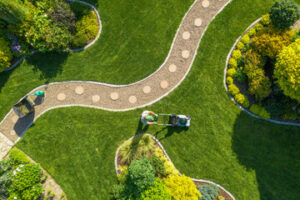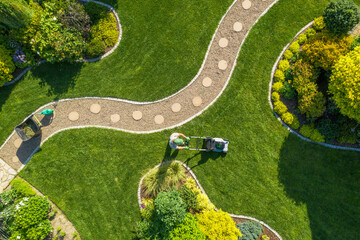Landscaping enhances property value, increases usable outdoor space, and makes gardens beautiful. It includes design planning and detailed terrain assessment, as well as planting and incorporating structures like patios and decks.
The visual qualities of line, form, texture, color and visual weight influence people’s responses to landscapes. The principles of composition–proportion, order, repetition, and unity–help determine how these elements are organized. Visit https://www.landscaping-greensboro.com/ to learn more.
The hardscaping element of landscape design takes your outdoor living space to the next level. Patios, walkways, driveways, garden walls, fire pits and water features all fall under the hardscaping category. These types of elements not only add beauty and function to your yard but also can increase your property value.
A key advantage of hardscaping is its low maintenance. Unlike plants, which require regular care and attention, hardscapes like stone pathways and gravel beds can go a long way in enhancing your landscape without demanding much from the owner.
Moreover, hardscapes are very functional in terms of erosion prevention and flood control. By directing runoff and rainwater away from your home, they help minimize erosion, soil saturation, and flooding. In addition, well-placed retaining walls and terraces can create usable levels on sloped properties.
Another benefit of hardscapes is their ability to complement your home’s architecture. The right stone or concrete patio, for example, can make your outdoor space feel like an extension of your home. And if you opt for a permanent shade structure, you can keep your yard cool throughout the day.
Finally, hardscaping can serve as a deterrent against unwanted pests and animals. For example, retaining walls and fences can prevent animals from accessing your gardens and other landscaped areas. This is especially important in areas prone to wild animal intrusions.
When used correctly, hardscapes can be the backbone of your landscaping project. By creating designated spaces for different purposes, they can enhance the overall functionality of your landscape. And when they’re designed with aesthetics in mind, they can create a cohesive and polished look that will impress your guests.
With so many benefits, it’s easy to see why hardscapes are becoming increasingly popular in landscape design. If you want to transform your outdoor space into a functional and beautiful retreat, contact us today for a consultation! We’ll help you choose the best hardscape elements for your landscape and incorporate them into your design plan. We’ll also provide tips on how to maintain your hardscapes so they last for years to come.
Softscaping
Softscaping refers to the living elements of a garden that create movement, color, and a sense of a landscape that evolves with the seasons. It combines trees, shrubs, flowers and grass to make your yard feel alive and inviting. It’s an important part of your landscape, as it adds to the curb appeal and property value of your home.
A softscape garden can be simple or complex, depending on your style and preferences. For example, you might plant a mix of annual flowering plants such as lupine, lavender, basil and sweet alysum to bring in color throughout the year. Or you might plant feathery ornamental grasses such as miscanthus and fountain grass alongside stepping stones to create a flowing edge.
Ground cover can be a beautiful and functional element of softscaping, as it can prevent erosion and help with water retention in the soil. It’s important to consider the light needs of each type of plant as well. Putting shade-loving plants in the sun, for instance, can lead to overgrowth and competition between plants.
Choosing native plants or drought-tolerant species can also help reduce the need for water and maintenance, as they are adapted to your local climate. Native plants also support biodiversity and contribute to a healthy ecosystem, which helps protect the environment and enhances your quality of life.
Plants can also provide a privacy screen or barrier, and you can even use them to block noise from the street or neighbors. Incorporating these features into your softscape can make your backyard a private oasis that you can enjoy all year round.
Fences
Fencing can improve the appearance of your property while adding privacy and security. You can choose from a variety of fencing solutions, including wood, vinyl, and metal. There are also different styles of fences, from pickets to lattice, and these options can vary in height and thickness levels. If you are worried about resale value, ask an appraiser or a local real estate agent for advice before installing a new fence.
Wood fences can add a natural look to your yard, while vinyl and metal fences are low-maintenance options that offer an array of colors. If you decide to build a wood fence, make sure you use pressure treated lumber. This will help protect against insects and rot, and it is also easier to work with. It is important to wait a few weeks before staining or painting your fence, as the wood needs time to dry. You should also wear a dust mask and eye protection when working with treated wood.
If you want to create a more modern look, consider a fence made from corrugated metal panels or chain link. These fences are often used to separate properties and can be a good choice for homes with pools or other water features in the yard. They are also affordable and easy to install. If you prefer a more traditional look, you can try a wood and metal combination. This style uses both wood for the frame or panels and metal for the posts or rails. You can also alternate the panels between wood and corrugated metal to add a more visual interest.
Another option is a decorative fence that uses wrought iron or aluminum for the frame and pickets. These types of fences are often used to define the boundary of a property, as they are durable and look attractive. They are also a good choice for homeowners who have children or pets. They can keep out intruders and animals, and they can be installed with gates to prevent children or pets from leaving the yard. They can be finished with a number of different accessories, such as finials or dome caps.
Lighting
Your landscaping is a big investment of time and money. It’s important to show it off, even after dark. Landscape lighting is an excellent way to do just that, while promoting safety and adding a beautiful touch to your home’s exterior design.
Landscape lighting illuminates walkways, paths and stairs, making it easier to navigate your property safely after dark. It also acts as a deterrent for criminals, who are less likely to target properties that are well-lit. It’s easy to see why so many homeowners are choosing to invest in landscape lighting to complement their homes.
Accent lighting focuses on providing focused light to highlight landscape features, such as a fountain or trees, with the goal of creating a visual effect. It can create a romantic atmosphere for evening entertaining, or a calming, peaceful mood for a backyard retreat. It can also help bring out the color and texture of your flowers and plants.
Step lights and deck lighting are also an essential part of any landscape design. They help prevent accidents after dark, preventing falls and injuries, especially for elderly or disabled people. They can also be used to illuminate stairs or areas where the ground is uneven, reducing the risk of tripping or falling over obstacles.
When properly installed, outdoor lighting will enhance your home’s curb appeal and make it stand out from the rest of the neighborhood. It will also increase the value of your property, bringing in more potential buyers. You can even set up a smart control system, which will let you schedule and adjust your lighting remotely on your mobile device.
With the right lighting, your landscaping can be enjoyed all day and night. Contact a professional landscaping team to learn more about how you can add a little extra illumination to your yard and garden. The results will be worth the effort! After all, your landscape is a reflection of your home, and you want to be able to enjoy it at any time. So, what are you waiting for?


